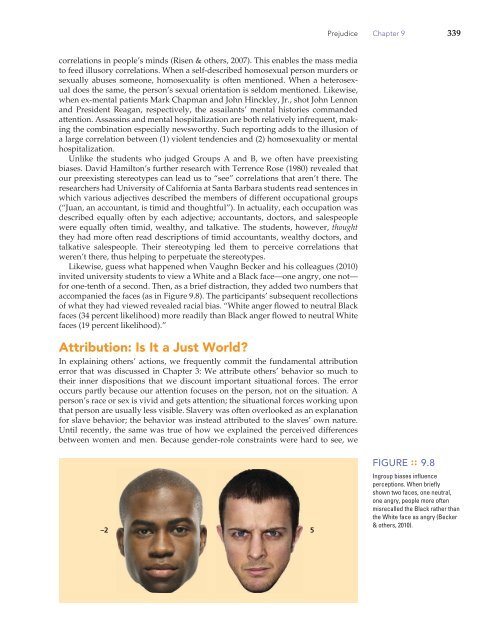Chapter 9: Prejudice: Disliking Others (2947.0K) - Bad Request
Chapter 9: Prejudice: Disliking Others (2947.0K) - Bad Request
Chapter 9: Prejudice: Disliking Others (2947.0K) - Bad Request
You also want an ePaper? Increase the reach of your titles
YUMPU automatically turns print PDFs into web optimized ePapers that Google loves.
correlations in people’s minds (Risen & others, 2007). This enables the mass media<br />
to feed illusory correlations. When a self-described homosexual person murders or<br />
sexually abuses someone, homosexuality is often mentioned. When a heterosexual<br />
does the same, the person’s sexual orientation is seldom mentioned. Likewise,<br />
when ex-mental patients Mark Chapman and John Hinckley, Jr., shot John Lennon<br />
and President Reagan, respectively, the assailants’ mental histories commanded<br />
attention. Assassins and mental hospitalization are both relatively infrequent, making<br />
the combination especially newsworthy. Such reporting adds to the illusion of<br />
a large correlation between (1) violent tendencies and (2) homosexuality or mental<br />
hospitalization.<br />
Unlike the students who judged Groups A and B, we often have preexisting<br />
biases. David Hamilton’s further research with Terrence Rose (1980) revealed that<br />
our preexisting stereotypes can lead us to “see” correlations that aren’t there. The<br />
researchers had University of California at Santa Barbara students read sentences in<br />
which various adjectives described the members of different occupational groups<br />
(“Juan, an accountant, is timid and thoughtful”). In actuality, each occupation was<br />
described equally often by each adjective; accountants, doctors, and salespeople<br />
were equally often timid, wealthy, and talkative. The students, however, thought<br />
they had more often read descriptions of timid accountants, wealthy doctors, and<br />
talkative salespeople. Their stereotyping led them to perceive correlations that<br />
weren’t there, thus helping to perpetuate the stereotypes.<br />
Likewise, guess what happened when Vaughn Becker and his colleagues (2010)<br />
invited university students to view a White and a Black face—one angry, one not—<br />
for one-tenth of a second. Then, as a brief distraction, they added two numbers that<br />
accompanied the faces (as in Figure 9.8 ). The participants’ subsequent recollections<br />
of what they had viewed revealed racial bias. “White anger flowed to neutral Black<br />
faces (34 percent likelihood) more readily than Black anger flowed to neutral White<br />
faces (19 percent likelihood).”<br />
Attribution: Is It a Just World?<br />
In explaining others’ actions, we frequently commit the fundamental attribution<br />
error that was discussed in <strong>Chapter</strong> 3: We attribute others’ behavior so much to<br />
their inner dispositions that we discount important situational forces. The error<br />
occurs partly because our attention focuses on the person, not on the situation. A<br />
person’s race or sex is vivid and gets attention; the situational forces working upon<br />
that person are usually less visible. Slavery was often overlooked as an explanation<br />
for slave behavior; the behavior was instead attributed to the slaves’ own nature.<br />
Until recently, the same was true of how we explained the perceived differences<br />
between women and men. Because gender-role constraints were hard to see, we<br />
–2 5<br />
<strong>Prejudice</strong> <strong>Chapter</strong> 9 339<br />
FIGURE :: 9.8<br />
Ingroup biases influence<br />
perceptions. When briefly<br />
shown two faces, one neutral,<br />
one angry, people more often<br />
misrecalled the Black rather than<br />
the White face as angry (Becker<br />
& others, 2010).

















